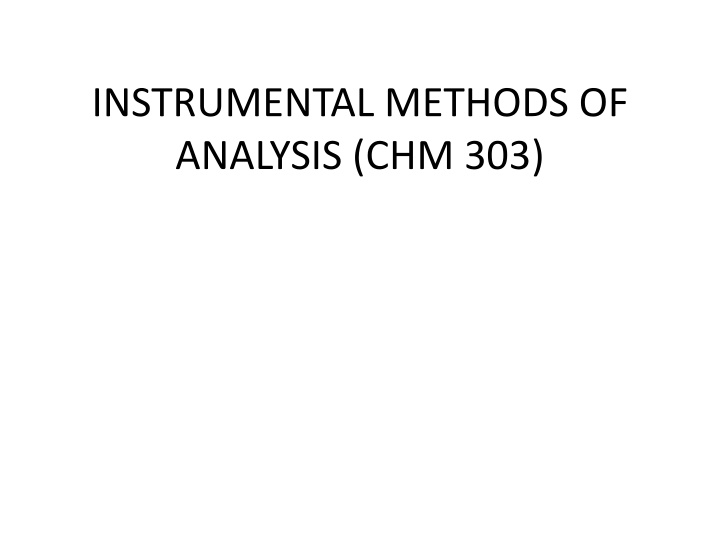
Exciting Fluorescence: Analyzing Molecular Properties with Fluorometry CHM 303
"Explore the fascinating world of molecular fluorescence and instrumental methods of analysis in CHM 303. Discover how molecules transition between electronic states, emit photons, and exhibit fluorescence and phosphorescence. Understand the principles behind Beers Law and how substances interact with radiation to produce fluorescence. Dive into the intricate processes of excited and ground states, absorption, and emission of energy in this enlightening study of fluorescence spectroscopy."
Download Presentation

Please find below an Image/Link to download the presentation.
The content on the website is provided AS IS for your information and personal use only. It may not be sold, licensed, or shared on other websites without obtaining consent from the author. If you encounter any issues during the download, it is possible that the publisher has removed the file from their server.
You are allowed to download the files provided on this website for personal or commercial use, subject to the condition that they are used lawfully. All files are the property of their respective owners.
The content on the website is provided AS IS for your information and personal use only. It may not be sold, licensed, or shared on other websites without obtaining consent from the author.
E N D
Presentation Transcript
INSTRUMENTAL METHODS OF ANALYSIS (CHM 303)
especially when absorbing high energy radiation like UV, only part of the energy is lost by collision; the electron then drops back to ground state by emitting a photon of lower energy (longer wavelength) than the one absorbed.
region. Molecules at room temperature are in ground electronic state. It absorbs energy and goes to excited electronic state. The groups of lines represent vibrational state. The entire process takes place in a very short time ( 10-12 10-9s). The absorption requires about 10-15s while the collision takes about 10-8s.
h1 h 2
thus emits a photon of energy h2 at a longer wavelength which is lower than h 1absorbed. This emitted light is fluorescence . In some cases, the electron crosses over to a triplet state (i.e. it becomes unpaired) before emitting a photon. This takes a longer time >10-9s. the emitted radiation is then called phosphorescence. Both processes are called luminescence.
a excitation b fluorescent
of radiation transmitted by a substance or solution but modification becomes necessary for fluorescence since radiation is emitted and not transmitted
Beers law: ln T = ln P/Po = - abc
Where F is the intensity of fluorescent radiation, k is constant (quantum yield), Po is incident radiation and P is transmitted radiation.
I.e. F (Po - P) i.e. radiation is absorbed.
Where Po is the power of incident radiation and P is the power of transmitted radiation.
= Po (1 e- abc) (3)
F = K (Po - P) = KPo (1 e- abc) . (4)
From (1), if no light is transmitted, i.e. all incident radiation is absorbed,
Fo = KPo (5)
ln Fo/ Fo F = abc . (7)
factors such as the dimensions of the light beam, area of the solution irradiated, transmission band of filter before photocell, spectral response of photocell etc. a is constant absorptivity.
b is the path length (thickness) of cell, c is concentration. When abc is small and negligible compared to 1, ( 0.01), equation (4) becomes
F = 2.303 KPo . abc (8) (Proved)
= KC (9)
i.e. F C if abc 0.01. K is constant for a particular substance in a given instrument.
solutions (when most of the radiation is transmitted, 92%) and breaks down at higher concentration. As usual, there should be no dissociation or association of molecules.
one or more electron donating group enhances fluorescence e.g. OH, -NH2, -OCH3etc. Polycyclic compounds like vitamin K, purines and nucleosides and conjugated polyenes like vitamin A are fluorescent. Groups like NO2, -COOH, -CH2COOH, -Br, -I, and azo groups tend to inhibit fluorescence. The nature of other substituent may affect the degree of fluorescence. The fluorescence of many molecules is pH dependent as only the ionized or un-
fluorescent compounds by dehydrating with conc. H2SO4which convert these cyclic alcohols to phenols. Similarly, dibasic acids e.g. maleic acid can be reacted with - naphtha in conc. H2SO4to form a fluorescent derivative.
chelates with organic ligands. Antibodies can be made fluorescent by condensing them with fluorescein isocyanate which reacts with free amino groups of the proteins.
fluorescence quenching. Some molecules do not fluoresce, whose bond dissociation energy is less than that of incident radiation. Instead of getting excited, a bond is broken. Also, coloured species in solution with fluorescing species may interfere by absorbing the fluorescent radiation. This is inner filter effect. For example, in Na2CO3solution, K2Cr2O7 has absorption peaks at 245 and 348 nm, which overlap with excitation (275
dilute solutions due to adsorption onto container surface which leads to significant errors. The problem is negligible in more concentrated solutions. Organic substances at < 1 ppm in organic solvents are adsorbed onto glass surfaces. Addition of small amount of more polar solvent may decrease it.
concentration. The fluorescent intensity (power) is measured and a calibration curve is plotted. The intensity of the sample solution is also measured and concentration is read from calibration curve.
(1.5m) for near I.R and 1.5m to 300 m for the far I.R, but the most useful region is from 2.5 m to 25 m which is most frequently used for analysis.
N N, H-H, O=O, without dipoles cannot absorb in I.R region. C O has dipole moment and will absorb CO2is symmetrical and has no net dipole and not expected to absorb in I.R but by vibration, it develops dipole and absorbs. In the vibration mode (a), there exist symmetry and no absorbance while in mode (b), there exist no symmetry and it absorbs.
